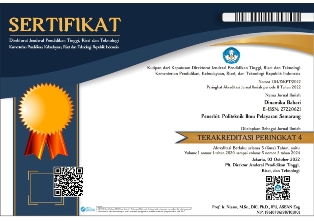Pengaruh Salinitas Air Laut Terhadap Laju Korosi Pada Plat Lambung Kapal Bobot 1500 DWT
Abstract
Ships are a means of transportation over the sea, where ships play a vital role in the socio-economic aspect through their distribution function between regions. One part of the ship that is often damaged is the hull of the ship. The cause of hull damage is corrosion. The aspect of high and low level of corrosion on the hull is the salinity content in seawater. This study aims to determine the effect of salinity in seawater on the rate of corrosion on the hull plate with seawater media taken from the waters of the port of Tanjung Emas Semarang. This study used an experimental test method of weight loss (weight loss) referring to the ASTM G31-72 standard. With specimens made coupons to calculate the weight before immersion and weight calculation after soaking. Soaking is carried out for 7 days in the prepared corrosion installation. The results of this study indicate that seawater which has a higher salinity content than brackish water and fresh water has a higher corrosion rate than other coupon specimens.
Downloads
References
Abbas, M., & Shafiee, M. (2020). An overview of maintenance management strategies for corroded steel structures in extreme marine environments. Marine Structures, 71, 102718. https://doi.org/https://doi.org/10.1016/j.marstruc.2020.102718
ASTM International. (2015). ASTM D2688 - 15e1: Standard Test Method for Corrosivity of Water in the Absence of Heat Transfer (Weight Loss Method). ASTM International. https://doi.org/10.1520/D2688-15E01
Benea, L., Simionescu, N., & Mardare, L. (2020). The effect of polymeric protective layers and the immersion time on the corrosion behavior of naval steel in natural seawater. Journal of Materials Research and Technology, 9(6), 13174–13184. https://doi.org/https://doi.org/10.1016/j.jmrt.2020.09.059
Bialystocki, N., & Konovessis, D. (2016). On the estimation of ship’s fuel consumption and speed curve: A statistical approach. Journal of Ocean Engineering and Science, 1(2), 157–166. https://doi.org/https://doi.org/10.1016/j.joes.2016.02.001
Gong, C., Frangopol, D. M., & Cheng, M. (2020). Risk-based decision-making on corrosion delay for ship hull tankers. Engineering Structures, 212. https://doi.org/10.1016/j.engstruct.2020.110455
Hu, Y., Wu, S., Withers, P. J., Cao, H., Chen, P., Zhang, Y., Shen, Z., Vojtek, T., & Hutař, P. (2021). Corrosion fatigue lifetime assessment of high-speed railway axle EA4T steel with artificial scratch. Engineering Fracture Mechanics, 245, 107588. https://doi.org/https://doi.org/10.1016/j.engfracmech.2021.107588
Kim, D. K., Wong, E. W. C., & Cho, N.-K. (2020). An advanced technique to predict time-dependent corrosion damage of onshore, offshore, nearshore and ship structures: Part I = generalisation. International Journal of Naval Architecture and Ocean Engineering, 12, 657–666. https://doi.org/https://doi.org/10.1016/j.ijnaoe.2020.06.007
Komite Nasional Keselamatan Transportasi RI. (2016). Data Investigasi kecelakaan pelayaran tahun 2010-2016.
Li, H., Yu, H., Zhou, T., Yin, B., Yin, S., & Zhang, Y. (2015). Effect of tin on the corrosion behavior of sea-water corrosion-resisting steel. Materials & Design, 84, 1–9. https://doi.org/https://doi.org/10.1016/j.matdes.2015.06.121
Okumoto, Y., Takeda, Y., Mano, M., & Okada, T. (2009). Design of Ship Hull Structures. In Hull Structure Design System (pp. 81–95). Springer. https://doi.org/https://doi.org/10.1007/978-3-540-88445-3_4
Pérez, F., & Clemente, J. A. (2011). Constrained design of simple ship hulls with B-spline surfaces. Computer-Aided Design, 43(12), 1829–1840. https://doi.org/https://doi.org/10.1016/j.cad.2011.07.008
Refait, P., Grolleau, A.-M., Jeannin, M., François, E., & Sabot, R. (2018). Corrosion of mild steel at the seawater/sediments interface: Mechanisms and kinetics. Corrosion Science, 130, 76–84. https://doi.org/https://doi.org/10.1016/j.corsci.2017.10.016
Sasono, E. J. (2010). Efektifitas penggunaan anoda korban paduan aluminium pada plat baja kapal AISI 2512 terhadap laju korosi di dalam media air laut. Universitas Diponegoro.
Zayed, A., Garbatov, Y., & Guedes Soares, C. (2018). Corrosion degradation of ship hull steel plates accounting for local environmental conditions. Ocean Engineering, 163, 299–306. https://doi.org/https://doi.org/10.1016/j.oceaneng.2018.05.047














